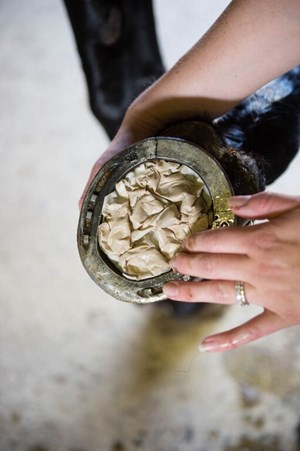It may be old-fashioned and low-tech, but nothing spells relief to a hurting horse like a poultice in a pinch.
Some poultices are designed to reduce heat and swelling in joints or tendons, while others are intended to relieve stiffness in those same areas, and still others to draw out an infection or an abscess developing in the hoof. Some are either heat-producing or microwave-hot, while others are chilled in the freezer for best effect.
THE MESSY NEWS
At the heart of every poultice is one gooey, gloppy, slimy substance or another. Depending on its purpose, it could be anything from kaolin clay, a blend of Epsom salts and bran, Kaopectate and flour—even mixtures of baking soda and witch hazel, povidone iodine and sugar, etc., etc. Once made into a paste, this is generally what happens:
1. The mixture itself is applied to the affected area by hand.
2. The area is then wrapped with plastic (usually either a sandwich bag or plastic wrap).
3. … and then the whole concoction is bandaged and left for awhile to work its magic, after which it must be washed (sometimes even scrubbed) off.
THE GOOD NEWS
If you don’t have time to mix your own poultice (or want to avoid the mess!), commercial preparations are readily available at tack stores and veterinary supply outlets.
Taking the concept of user-friendliness even farther, Bigeloil Quilted Poultice Wraps are a neater option for use when heat or stiffness is a concern, or when there is soreness, filling or bruising. Thanks to special quilted fiber pockets that contain a traditional mixture of kaolin clay and Epsom salts, application couldn’t be easier, and removal is a breeze, too, with no unsightly residue to curry or wash off.
How to apply new Bigeloil Quilted Poultice Leg Wraps:
1. Soak the poultice wrap for 20 seconds in either warm or cold water.

2. Apply to leg.

3. Simply cover with standing wrap.
4. When it’s time to remove the poultice, just take off the quilted poultice wrap and discard.
Oh, and they’re available in Quilted Poultice Hoof Pads, too. Learn how to apply Bigeloil Quilted Hoof Pads here.
SaveSaveSave












